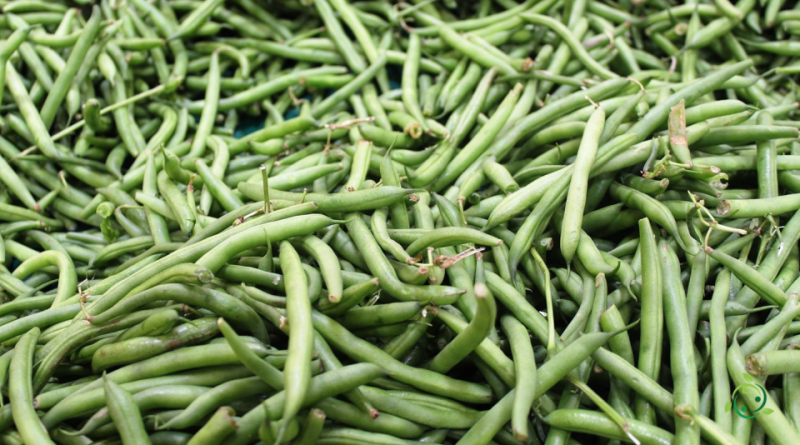Nutritional value of green beans
Nutritional value of green beans
The green bean is the green, unripe pod of several cultivars of the common bean plant (Phaseolus vulgaris L.), used as a vegetable.
For this reason they are collected and consumed with their pods, typically before the internal seeds have reached maturity.
Characteristics –
The bean is a herbaceous, annual plant, with different growth habits depending on the variety.
There are two main groups: climbing beans, similar to the original type, and upright, more branched beans.
The growth habit of the plant is mainly determined by its genome, but the ecological conditions in the various phenological phases can influence it. For example, a high temperature (30 °C) in the first trifoliate leaf phase always triggers a climbing habit.
The bean has a non-dominant main root that is quickly supplemented with lateral roots. The roots can reach a depth of one meter if the soil is suitable. the roots are in radical symbiosis with nitrogen-fixing bacteria, mainly Rhizobium etli and Rhizobium phaseoli. The optimal conditions for the development of nodules are a temperature of 25 to 30 °C and a pH of 6 to 7. The amount of nitrogen fixed can reach 200 kg per hectare.
The climbing stems are not very branched and wrap around their support in a counterclockwise direction. They can reach 2-3 meters in height. the dwarf cultivars are more branched, erect, 40 to 60 cm tall and are better suited to crop mechanization.
The adult leaves are petiolate, sticulate, alternate and trifoliate. The leaflets have an oval-sharp shape, almost lozenge-shaped and are 6 to 15 cm long and 3 to 11 cm wide.
For the production of green beans, the plant does not have to mature as the pods are harvested while they are still green.
Nutritional sheet –
Green beans are a very popular and therefore cultivated food.
The following is an approximate nutrition sheet for 100 grams of cooked green beans. However, keep in mind that the exact values may vary depending on the cooking method, the variety of green beans and the cultivation technique:
– Calories: 31 kcal
– Protein: 1.83 grams
– Carbohydrates: 7.03 grams
– of which sugars: 1.03 grams
– Fibers: 2.7 grams
– Fat: 0.22 grams
– Vitamin A: 1640 IU (33% of the recommended daily requirement)
– Vitamin C: 12.2 mg (20% of the recommended daily requirement)
– Vitamin K: 48.2 mcg (60% of the recommended daily requirement)
– Folate: 33 mcg (8% of the recommended daily requirement)
– Potassium: 209 mg
– Iron: 0.93 mg (5% of the recommended daily requirement)
– Calcium: 37 mg
– Magnesium: 18 mg
– Phosphorus: 38 mg
In general, green beans are a good source of vitamin K, vitamin C, folate and potassium. They are also a moderate source of protein and fiber. These nutritional values make green beans a healthy choice for enriching your diet with essential vitamins and minerals, as well as providing fiber that can be beneficial for digestion.
Property –
Green beans are a popular vegetable in many cuisines due to their mild flavor and versatility in cooking. Below are the main properties of these vegetables:
1. Low-calorie: Green beans are a low-calorie food, making them a healthy choice for those trying to control their weight.
2. Rich in fiber: They are a good source of dietary fiber, which can aid in digestion and help keep blood sugar levels stable.
3. Vitamins and minerals: Green beans contain vitamins such as vitamin A, vitamin C, vitamin K and some of the B group (for example, B1, B2 and B6). They are also a source of minerals such as potassium, calcium, iron and magnesium.
4. Antioxidants: They contain antioxidants such as quercetin and luteolin, which can help protect cells from damage caused by free radicals.
5. Reduced risk of disease: Consuming green beans may help reduce the risk of some chronic diseases, such as heart disease and type 2 diabetes, thanks to their fiber and antioxidant content.
6. Phytochemicals: Green beans contain phytochemicals such as isothiocyanates, which may have anti-carcinogenic properties.
7. Low Fat: They are naturally low in saturated fat and cholesterol.
8. Natural diuretic: Their high water and potassium content can act as a natural diuretic, helping to eliminate excess fluid from the body.
9. Versatile Flavor: Green beans can be cooked in many different ways, including boiled, sautéed, roasted, steamed, or added to soups and stews.
10. Sustainability: Growing green beans requires fewer water resources than some other crops, making them a relatively sustainable choice.
It is important to note that the preparation and cooking of green beans can affect their nutritional value, so it is advisable to cook them healthily, avoiding the addition of large amounts of fat or calorie-rich seasonings.

